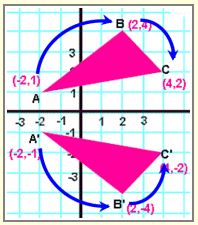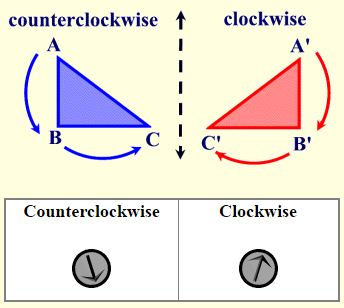General “Transformation” Vocabulary
The following vocabulary terms will appear throughout the lessons in the section on Transformational Geometry.
Image: An image is the resulting point or set of points under a transformation. For example, if the reflection of point P in line l is P’, then P’ is called the image of point P under the reflection. Such a transformation is denoted rl (P) = P’.

Isometry: An isometry is a transformation of the plane that preserves length. For example, if the sides of an original pre-image triangle measure 3, 4, and 5, and the sides of its image after a transformation measure 3, 4, and 5, the transformation preserved length.
A direct isometry preserves orientation or order – the letters on the diagram go in the same clockwise or counterclockwise direction on the figure and its image.
A non-direct or opposite isometry changes the order (such as clockwise changes to counterclockwise).

Invariant: A figure or property that remains unchanged under a transformation of the plane is referred to as invariant. No variations have occurred.
Opposite Transformation: An opposite transformation is a transformation that changes the orientation of a figure. Reflections and glide reflections are opposite
transformations.
 For example, the original image, triangle ABC, has a clockwise orientation – the letters A, B and C are read in a clockwise direction. After the reflection in the x-axis, the image triangle A’B’C’ has a counterclockwise orientation – the letters A’, B’, and C’ are read in a counterclockwise direction.
For example, the original image, triangle ABC, has a clockwise orientation – the letters A, B and C are read in a clockwise direction. After the reflection in the x-axis, the image triangle A’B’C’ has a counterclockwise orientation – the letters A’, B’, and C’ are read in a counterclockwise direction.
A reflection is an opposite transformation.
Orientation: Orientation refers to the arrangement of points, relative to one another, after a transformation has occurred. For example, the reference made to the direction traversed (clockwise or counterclockwise) when traveling around a geometric figure.
(Also see the diagram shown under “Opposite Transformations”.)

Position vector: A position vector is a coordinate vector whose initial point is the origin. Any vector can be expressed as an equivalent position vector by translating the vector so that it originates at the origin.
Transformation: A transformation of the plane is a one-to-one mapping of points in the plane to points in the plane.
Transformational Geometry: Transformational Geometry is a method for studying geometry that illustrates congruence and similarity by the use of transformations.
Transformational Proof: A transformational proof is a proof that employs the use of transformations.
Vector: A quantity that has both magnitude and direction; represented geometrically by a directed line segment.
